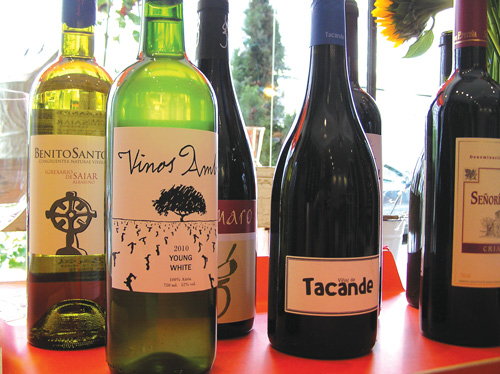caitlin@sfbg.com
BEER AND WINE The high priestess of natural wines and I are going out for a glass. As is to be expected of a meeting with a thought leader, it’s a learning experience.
Alice Feiring peruses the bar menu in front of her. It’s a nice enough place, the restaurant we’re at, and the wine list includes a few organic pours — but even these, Feiring says, were made with foreign yeasts and an excess of sulfur. The bartender tries lamely to help her order, but it’s apparent that even he is not sure what her criteria for an acceptable wine is. Finally, she finds a rose that will work.
Um, I’ll have the same.
“I’m kind of a bitch when it comes to wine,” she apologizes to me.
Her disclaimer is unnecessary — I’ve invited her here to teach me about a movement in the wine world that is turning conceptions of sustainable viniculture practices on their head. The bartender is to be excused for not knowing about it yet.
Feiring’s new book Naked Wine (231 pp, Da Capo, $24) is a declaration of her personal preference towards wines grown organically — as many wines are, particularly in California where you can find organic vintages wherever local, seasonal foods are favored — but it goes beyond that. Although a wine’s bottle may tell you it’s “made with organic grapes,” this says nothing about its life post-vine. Reverse osmosis, chemical additives, foreign yeasts, and more are all common practices in wineries. Feiring’s beloved natural wines don’t use any of these artificial aides.
For locavores, natural wine would seem like the, yeah, natural choice. But even when bottles say “made from organic grapes,” it’s hard to know what happened to the wine after it left the vine.
As Naked Wine puts it, “A truly natural wine, most natural wine proponents agree, is not possible in every year, but no one ever needs gum arabic, tannin addition, micro-oxygenation, or strong doses of sulfur at every stage.” In the back of the book, a list of chemical additives determined permissible for wine by the FDA are listed.
There are over 60 of these, including ferrocyanide compounds and colloidal silicon dioxide. Each time one of these substances are added, your wine is further away from a true expression of the terroir in which it was grown. All these chemicals are legal in wine “made from organic grapes.” Many conventional producers claim that without these crutches, winemaking can be neither cost-effective or competent — but to natural adherents, their presence obstructs the connection between terroir and taste.
The day after drinking with Feiring, I attended a screening of a new documentary on Californian natural wines, Wine From Here. After we watched the film (a lovingly shot, low budget homage to vignerons who spend their lives in pursuit of purity), the winemakers profiled were invited onstage for a Q&A. They represented some of the best natural wineries in the state — Clos Saron, Coturri, Old World Winery, Edmunds St. John, Dashe Cellars, La Clarine Farm, and the Salina and Natural Process Alliance.
A few of the vignerons said at various points they’d attempted to add an ingredients section to their labels that would read, simply, “grapes.” Officials balked, however, saying that the labels “would imply that other wines were made with things other than just grapes.”
But how do natural wines taste? Even Feiring writes in Naked Wine that “how one treated a wine was not a moral issue, after all.” (A view which possibly negates the environmental dimensions of viniculture; the link between more sustainable, organic farming practices and impact on ecosystems being fairly well established.)
The answer is: varying. Eschewing artificial chemicals and fermentation agents often means giving up standardized product. Natural wine can oxidize more easily than wine treated with sulfites. Reliance on natural yeast means that whatever Mother Earth brings to your grapes is what you end up tasting in the glass.
But for natural wine proponents, this kind of variation can be thrilling.
After my chat with Feiring, we hopped over to Biondivino, a fetchingly designed Russian Hill wine shop that specializes in Italian pours. Owner Ceri Smith stocks many natural wines, which she arranges like books in a library — a visual connection that’s strengthened by the rolling ladder Smith uses to access the top racks.
The tasting featured natural selections from the Spanish wine catalog of importer José Pastor. The man pouring us our sips seemed to be a bit cautious of the wines’ effect on newbies.
“Now this one is really, really unusual,” he told me, doling out a finger of Vinos Ambiz Airén from Madrid vigneron Fabio Bartolomei. He wasn’t kidding — it was probably the most distinctive wine I’ve ever tasted.
Although Airén is the most-harvested white wine grape in Spain, it’s usually made into nondescript wine sold in bulk. Not so with Bartolomei’s version. The winemaker eschews all additives besides some sulfur spray in his vineyard, and bottles the wine unfiltered. The result was a mouth-encompassing herbal wash, almost Fernet-like in its grassy, spicy taste. I was still wide-eyed when the next wine that found it’s way into my glass: Catalonia producer Laureano Serres’ “5 Anys i un Dia” (“Five Years and One Day” in Catalan).
“Is that… gasoline?” I asked Feiring, who was standing at my side. “You’re tasting sherry,” she smiled. Wild. But even more wild? All the bottles featured in the tasting were $25 and under.
Will Feiring become the wine world’s Michael Pollan, launching a thousand natural vignerons? Only time will tell — but regardless of the movement’s future, natural winemakers certainly pour a glass worth writing home about.

